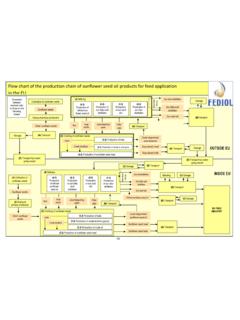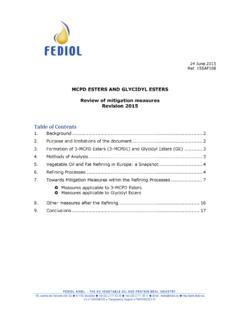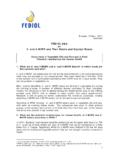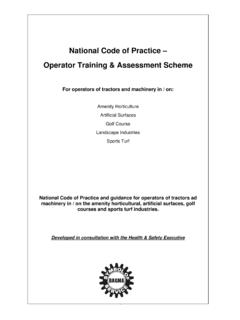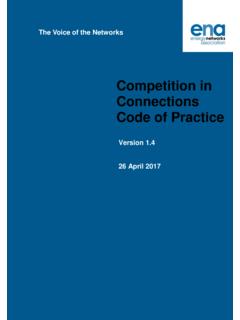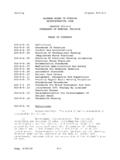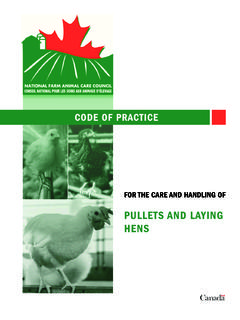Transcription of FEDIOL code of practice for the management of …
1 Brussels, 14 February 2018. Ref. FEDIOL code of practice for the management of mineral oil hydrocarbons presence in vegetable oils and fats intended for food uses The code of practice (CoP) developed by FEDIOL , in cooperation with its members, is a non-binding recommendation developed for the use of members and non-members. This CoP is based on the current status of knowledge at the moment of publication and is reviewed on a regularly basis. This CoP is applicable to all vegetable oils and fats intended to be used (as such or after processing) for food uses. For several years, FEDIOL has proactively set up monitoring measures to address mineral oil hydrocarbons (MOH) contamination in the supply chain of vegetable oils and fats.
2 FEDIOL has also worked on best practices for its sector to manage both identified and possible sources of MOH. These best practices are presented in this CoP. FEDIOL AISBL - THE EU VEGETABLE OIL AND PROTEIN MEAL INDUSTRY. 168, avenue de Tervuren (bte 12) B 1150 Bruxelles Tel (32) 2 771 53 30 Fax (32) 2 771 38 17 Email : Ets n 0843946520 Transparency Register n 85076002321-31. 14 February 2018. 1. Introduction Definition MOH comprise a diverse group of complex mixtures of hydrocarbons derived from crude mineral oil, containing a huge number of chemical compounds which are varying in size (carbon number) and structure. At the moment, MOH are defined from an analytical standpoint and are divided into two main types, depending on the analytical fraction in which they are recovered when using GC-FID1 methods: Mineral oil saturated hydrocarbons or MOSH: correspond to straight and branched open-chain alkanes (paraffins) and largely alkylated cyclo-alkanes (naphthenes).
3 Mineral oil aromatic hydrocarbons or MOAH: correspond mainly to alkylated (and in smaller amounts non-alkylated) polyaromatic hydrocarbons. As per their definition, MOH exclude: Hydrocarbons naturally occurring in food: such as n-alkanes of odd numbered carbons (from C21 to C35) or natural olefins of terpenic origin (such as squalene, sterene or carotenoids). Hydrocarbons from synthetic origin: such as POSH (polyolefin oligomeric saturated hydrocarbons) or PAO (poly alpha olefins). POSH are oligomeric substances, potentially migrating from plastic packagings ( polyethylene or polypropylene packagings). PAO are synthetic isoparaffins with short and long side chains used in synthetic lubricants and adhesives.
4 Risks associated with MOH. In 2012, the European Food Safety Authority (EFSA) published an opinion related to MOH in food2. In its opinion, EFSA found that MOH was present at different levels in nearly all foods. For MOSH, EFSA estimated that there was potential concern associated to the background exposure to MOSH and with the use of white mineral oils as release agents in bread and for spraying of grains. EFSA also considered the exposure to MOAH through food to be of potential concern because of its specific health risk. Toxicological data on the relevant fractions of MOSH and MOAH which are found in food are today still missing. The outcome of recent toxicological studies is also currently being discussed in the scientific community.
5 Lastly, it should be kept in mind that MOSH and MOAH are analytical concepts: because of the chemical and toxicological complexity of the mineral oil hydrocarbons encompassed under these 2 fractions, many uncertainties remain as to the risk for health associated with a certain level of MOSH or MOAH. 1. GC-FID: gas chromatography equipped with a flame ionization detector. 2. EFSA Panel on Contaminants in the Food Chain (CONTAM); Scientific Opinion on Mineral Oil Hydrocarbons in Food. EFSA Journal 2012;10(6):2704. [185 pp.] Available online: 2. 14 February 2018. Scope of this CoP. There is today no EU legislation regulating the limits of MOH in vegetable oils and fats.
6 Some discussions around possible MOH legislation (to restrict migration of MOH to food packed with recycled paper and board) are ongoing at national level. FEDIOL is committed overall to ensuring the safety and quality of vegetable oils and fats placed on the market in the EU. FEDIOL has therefore engaged proactively in the MOH issue in order to better understand it and to reduce the occurrence of MOH in marketed vegetable oil and fat products, and in particular reduction of MOAH (given their suspected toxicological profile). The following CoP is setting best practices : To prevent MOH contamination in vegetable oils and fats. To manage and mitigate identified sources of MOH.
7 2. Possible sources of MOH contamination in the vegetable oil and fat production MOH may be introduced at different stages of the vegetable oil and fat production: Agricultural stage: leaks of diesel or lubricant from the agricultural vehicles, use of pesticides, contamination from the environment (exhaust gasses from vehicles, ). Storage of the seeds/beans: use of anti-dusting agent in the grain handling facilities/silos, leaks of diesel or lubricant (during handling of the seeds/beans), contamination from environment (drying of the beans/seeds with wood or diesel fire combustion gases, ..), migration (in case of packaging of the seeds/beans). Transport of the seeds/beans: use of anti-dusting agent (during oversea shipping), contamination from the environment (debris from tires and road tar, ), leaks of diesel or lubricant from the transport vehicles.
8 Processing: leakage from the mineral oil absorber system (during crushing), contamination by lubricant (during crushing, refining or during maintenance procedures in the processing plant). Transport of the oil: contamination by a previous cargo, leaks from equipment ( pumps). Packing: packaging materials can be a source of contamination. Lubricants used during the manufacture of food cans (in which vegetable oils can be packed) or recycled cardboards and paperboards (that can be used as secondary or tertiary packaging) are relevant for FEDIOL sector. Economic adulteration3. 3. FEDIOL action plan Prevention of MOH contamination in vegetable oil and fat crushing and refining plants In FEDIOL members' HACCP4 systems, each point where MOH contamination may occur during crushing, processing and refining operation has been identified and procedures have been put in place so that the associated risk is kept under control.
9 3. In 2008, sunflower oil contaminated with mineral oil hydrocarbons (MOH) from unknown origin was exported from Ukraine to the EU (RASFF notification on 23 April 2008). 4. Hazard Analysis Critical Control Points 3. 14 February 2018. From the risk assessments conducted under their HACCP systems, FEDIOL member experts have particularly identified lubricants and special fluids (absorption oils, thermal heating fluids ) as possible contributors to the MOH contamination. A special attention is therefore paid to these products, especially from a MOAH perspective. Critical lubrication/fluid points5 in the plants are identified and clear procedures for the correct management of the lubrication/fluid systems are in place to prevent/minimize leakages/contact.
10 In all critical lubrication points, only food grade lubricants are used ( lubricants suitable for incidental contact with food6 or lubricants for direct food contact7). Remark: equipment in the production chain requires proper lubrication to operate at optimum performance and reliability. In specific cases where no food grade lubricant with high quality could meet the particular lubrication requirements of an equipment, a technical solution should be found to avoid leakage/contact. For the absorption oil used in the hexane recovery system, control measures are implemented so as to minimize transfer in the crude vegetable oils. Fluids used in indirect heating systems have a potential to incidentally contaminate vegetable oils, reason why it is required to use steam in processing installations8.
